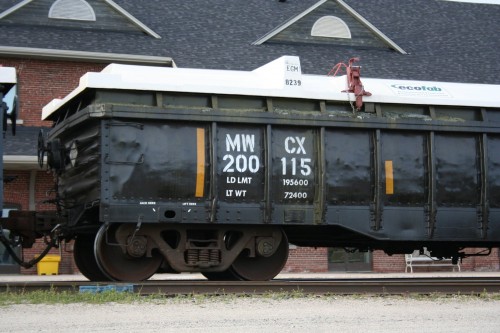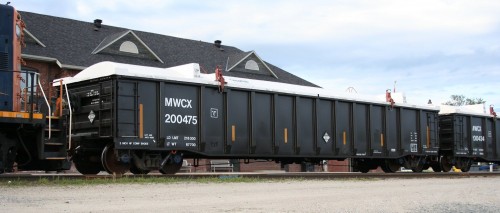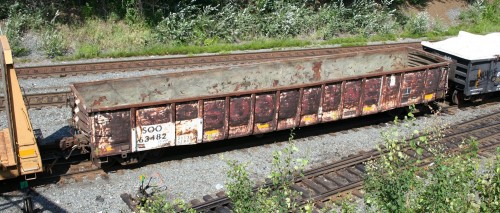One interesting source of current bridge traffic over the former Algoma Central is copper concentrate heading over the Ontario Northland Railway to be smelted at the large facility at Rouyn-Noranda, QC. This traffic apparently comes from the Michigan “Upper Peninsula” from the concentrator at the Humboldt Mill which was recently rebuilt and started ore production in 2014 and travels across CN up to Hearst to interchange with the ONR. The three photos of MWCX cars in this post were photographed on July 16, 2015 in Cochrane, Ontario, but had just arrived from Hearst that day. Several more cars (possibly even the same ones actually) were seen from a distance in the northern section of Hawk Junction yard a few days earlier.
MWCX 200115 is an older car originally built by Greenville Steel Car for the Pittsburgh & Lake Erie Railroad, and has had a few interim owners since them, one notable operator of these former P&LE cars being the Chicago & Northwestern Railroad. Its acquisition by Midwest Railcar Leasing (MWCX) is pretty recent however.
This closeup shot shows a fair amount of load spillage around the top edges of the car; you can see the buildup of the greenish-coloured ore copper ore concentrate in the dust on the side of the car.
This car, MWCX 200475, is a good example of the modern gondola on today’s railways, having been built in early 2015. One other car in this set of five was also built in 2014, and the others were older, but clearly quite recently shopped and repainted in 2014-2015.
While this movement (and certainly in these particular cars) seems to be a fairly new one, copper mining in the upper Michigan area seems to have been a sort of on-again, off-again affair, and shipments of ores from the states to the Noranda smelter seem to have occurred at various times in the past, so I might be able to make some sort of justification for adding a bit of this sort of traffic onto my eventual layout. (In older, contemporary cars of course.) There also seems to be some westward (to or from) interchange of ore concentrates in CN cars at Oba, possibly from as far away as Trail, British Columbia.
This SOO gondola photographed on July 17, 2013 in Sudbury (cars seen here would have been routed to/from points south via the ONR, OVR and CP) also shows telltale weathering of having been in concentrate service and provides a good look at the inside of the car. Note the caked-on greenish gray concentrate material on the interior sides. Today concentrates are shipped with fiberglass covers applied to the cars to prevent any loss in transit for both economic and, significantly, environmental concerns, but in the 1970s and early 1980s the stuff was actually shipped open. Bram Bailey’s book “Ontario Northland in Color” from Morning Sun Books has a couple of photos of trains with concentrate gondolas and a large greenish dust cloud trailing behind it…





Summer sucks for modelrailroading !! On the other hand I enjoy reading your site for ACR info even tho I live here and had many friends that worked the ACR over the years. If You haven’t already Wayne Britten contributed to a websight about CP SOOLINE and ACR. He was a long time engineer for the Wawa sinter plant to Algoma Steel back in the day…
This is old news, of course but a couple of points: these cars are shipping concentrate from the Eagle Mine mill in Humboldt, which began shipping in 2014 I believe. Since they produce copper and nickel, they ship to Glencore Rouyn-Noranda (copper), Vale Sudbury (nickel) and also export both materials through Trois Rivieres, Quebec.
You mention the copper concentrate spillage on the side of the tracks? Closer inspection shows that the ‘green buildup’ is in fact grass and weeds. It would be very very unusual to see copper spillage from covered cars, especially so far from their loading site. Eagle loads indoors, their spillage is very little and cleaned up before the car leaves the building. But no matter where they load, any spillage isn’t going to accumulate beside a track hundreds of miles away. And the green is wrong anyway, copper is more of a mint green when oxidized.
quizzard – I mentioned concentrate residue on the cars in the photos, not the tracks. You can see the buildup on the MWCX 200115 in the close-up shot and caked on the interior of SOO 63482.
Ontario Northland’s gondolas are mostly used for concentrate service between XStrata near Timmins (Kidd) and Rouyn-Noranda and similar show a lot of buildup of concentrate residue on the outside of the cars (especially the horizontal end sills) from spillage while loading. But it’s not spread along the tracks.
Thank you for the additional information though. Someone else had said to me before that they thought the cars went to Sudbury not Noranda, but obviously they therefore go to both places, since he personally saw them in Capreol and Sudbury and I personally saw them in Hearst and Cochrane. Copper to Noranda and nickel to Sudbury makes perfect sense. And all of this traffic would be using the former ACR – as far as Oba to connect to eastbound trains for Capreol/Sudbury and all the way to Hearst to connect to Ontario Northland for Rouyn-Noranda. Interesting traffic for anyone following present-day Sudbury area, Ontario Northland, or former Algoma Central.
Thanks Phil.
I’ve seen Wayne’s name connected to an older article published on Ray Kennedy’s “Old Time Trains” site on TrainWeb. I’ve never had any contact with Wayne though.
If you’ve got some local contacts there, I might have to poke your brain (or the collective brains of some of your contacts) for information sometimes. I’m always happy to have any of my assumptions challenged or verified and get a better cohesive picture of the railway. I’m sure there’s a lot of unknowns out there that I’m just not aware of and might not have ever considered.
I did ask Reg Fitzpatrick (former station agent/operator at Franz in the ’80s until the station was closed ~1992) about concentrate traffic and he said the only similar stuff he ever saw was moving on the CP from Manitouwadge to points east; nothing on the ACR, at least in that time frame.
I had to go to my ASC history books to find more info Algoma Ore Division henceforth AOD. ACR shipped iron ore to a blast furnace in Midland On. to be converted to pig iron and shipped back to Iron and steel Co. in the Sault. It in the Sault appears that when a blast fce was built the ore from AOD was shipped here that would have been early 1900’s. the wawa mine ran for about 20 years and then with current technology was considered played out. There was still many tons of iron ore in the Wawa mines but it took Sir James Dunn and his lab Techs to figure a way to make the poor quality ore worthwhile. Sintered iron ore was the solution. This was approx. in 1939. Dunn built a sinter plant in Wawa and the shipped sintered ore to ASC for the next 60 years give or take. Don’t have any info on hand for engines or ore cars back in the day, but in my time they used SD diesels I believe and Ortner ore cars. What I called veranda cars because of the platforms at either end. I seem to remember Walthers had models of that style of car in there catalogue but don’t know if they are still available. ASC and ACR fed off each other for generations. After all at one point they were owned by one man one building off the other. I think Francis H. Clergue built the railroad the steel mill and the paper mill just to keep all his holdings in one place to keep an eye on his growing empire. Sorry for being so long winded but ACR ASC and Abitibi Paper Mill were the cornerstones of my city for generations. I can comfortably say over the last 100 years or so 100,000 people thru the generations have worked and died in these companies so I have an attachment to all of them
Regards
Phil
In the early 1900s the ACR rostered a few hundred small steel ore hopper cars acquired from the Pressed Steel Car Co. I think these mostly disappeared when the original Helen Mine shut down as you mentioned above. The railway didn’t even connect the Sault to Hawk Junction until at least 1910, so the ore all went out the Michipicoten harbour by ship.
When the Wawa plant was built and the mining started up again around 1939, the ACR acquired several groups of standard 2-bay hoppers from various US sources. These ran into the 1970s when they got replaced by the larger black (in 1970) and green (the “Ortners”) (in 1974-75) cars, at which point the old cars were pretty much starting to completely wear out. The 1970s built cars were used for the rest of the life of the Wawa plant.
Now, the gondolas shown in this post are carrying copper ore concentrate from Michigan, not iron (either raw or processed) but it’s neat to see some mining traffic flowing through again. Iron ore for Essar Steel Algoma is still brought in by rail, but from the US, so naturally doesn’t come north of the yard.
PS, don’t apologize. I’m happy to have some discussion!
One thing I didn’t mention was at one point ACR was shipping 85000 tons a month of sintered ore up until the mid 90’s when a cheaper method was found. I think they shut AOD down in 1998 or 1999
I have 1998 in my notes as well.
Consequently as there was no other traffic on the branch anymore it was abandoned and ripped out. I can’t find it right now, but I did before find the formal abandonment approval on the Transport Canada site and it was officially abandoned in 2000. (It’s approximately a 3-year process.) The rails were torn out by 2001.